Personalized Chinese Tourism Recommendation Algorithm Based on Knowledge Graph
Abstract
1. Introduction
- In response to the lack of the public Chinese tourism Knowledge Graph, this paper introduces a Knowledge Graph into the tourism field, analyzes knowledge characteristics of tourist attractions, realizes the division of the entities and the relationship among tourist attractions, and constructs a complete Chinese tourism Knowledge Graph.
- Aiming at the problem of a high error rate in constructing negative triples, this paper introduces Bernoulli sampling strategy and proposes a new knowledge representation model of B-TransD (Bernoulli-TransD) to reduce the probability of false negative triples.
- Because the traditional recommendation algorithm only relies on the user’s historical behavior, but does not consider the attribute information of users or tourist attractions, this paper proposes a new method of user interest based on the attribute of the tourist attraction, and excavates the user preferences for tourist attraction, building the user interest model to improve the performance of the recommendation system.
2. Related Work
- The recommendation generation is based on ontology. The advantages of this method are that it combines the user and environment, provides user-centered route planning based on the hierarchical relationship of concepts in ontology, overcomes the shortcomings of standard modeling, and improves the accuracy of recommendation. It can also fine-grain the context of relation, enhance the relevance of data, and provide more fine-grained analysis of the user preferences. However, the disadvantages lie in the high construction cost and needing the participation of experts, the limited number of general large-scale ontologies, needing to update ontology knowledge base, and the complexity of the update process [8].
- Recommendation generation is based on open link data. The method has the advantages of sufficient data, wide range, strong data association, accurate expression form, logical reasoning ability, and can mine and analyze effective information to improve the recommendation performance. However, the disadvantage is that the quality of the open link data can affect the quality of the recommended results [9,10].
- The recommendation method is based on knowledge representation learning. The advantages of this method are that users or a tourist attraction is represented as a low-dimensional dense vector and the computational complexity is effectively reduced, as well as the computational efficiency and the recommendation performance being improved. However, it relies on the knowledge representation technology, which has low efficiency in the input module and the perception of a dynamic structure [11,12,13].
3. Methodology
3.1. Tourism Knowledge Graph
3.1.1. Collecting Tourist Data
3.1.2. Building Tourism Knowledge Graph
- Defining the entities and related concepts in the field of tourism. The attribute of tourist attractions include location, type, dynasty, ticket price, official website, average score, opening time and so on. Among them, type, score, location will affect the recommendation result. For example (Figure 1), a tourist attraction may belong to different types. Therefore, this paper defines tourist attractions, the type of tourist attractions, the average score of tourist attractions, and the location of tourist attractions as entities.
- Name entity recognition. Name entity recognition originally uses a rule-based and dictionary-based method. The domain experts make effective rules to identify entities in the text, but this method is time-consuming, labor-intensive, and poorly applicable. Deep learning can automatically learn features that are effective for the target, and can achieve good results without relying on feature engineering and domain knowledge. After experimental comparison, this paper uses Bidirectional long short-term memory network and a conditional random field model (Bi-LSTM+CRF) for entity recognition.
- Defining entity attributes and value ranges. The attributes of the entity in ontology can be divided into two categories: object attribute and data attribute. Object attribute is used to describe the relationship of objects, and its value domain is an entity object. Data attribute is used to describe the inherent attribute of the entity, and it has transitivity, that is, the data attribute owned by the upper entity and inherited by the lower entity, and the value range is generally String, as shown in Table 2.
- Creating an example of the ontology. Through steps 1, 2, and 3, complete the construction of the ontology database of tourist attractions, then instantiate the ontology, fill the Knowledge Graph data layer, and complete the construction of the tourism Knowledge Graph.
3.1.3. Construction Method of Graph Based on Neo4j
3.2. B-TransD Knowledge Representation Model
- (1)
- When the relationship type is one-to-many, and , more head entities are replaced, and the error probability of marking the positive triples formed by replacing tail entity as negative triples is reduced.
- (2)
- When the relationship type is many-to-one, and , more tail entities are replaced and the error probability of marking the positive triples formed by the replacement head entity as negative triples is reduced.
- (3)
- When the relationship type is many-to-many, and , consider the number of head entities and tail entities connecting the relationship, and choose the entity with relatively low error rate to replace. In model training, positive and negative triples are effectively separated in the vector space by maximum interval. In this paper, the distance-based sorting error function is used as the optimal objective function for model training.
- (4)
- In the objective function, is a hinge loss function, ensuring that each cumulative subterm is not a negative number. T is a set of positive triples in the Knowledge Graph, is a set of negative triples, and is the distance of separating positive and negative triples, generally set , the loss of the correct triplet is close to 0, while the loss of the wrong triplet tends to infinity. For the objective function, the stochastic gradient descent algorithm is used to obtain the minimized the loss function and update the model parameters by an iterative solution. The specific training steps are as follows: (1) randomly traversing a positive triplet from the Knowledge Graph, and constructing the corresponding negative triplet; (2) normalizing the entities in the positive and negative triples into the embedding vectors, setting the learning rate to calculate the gradient direction by learning each sample and updating the parameters of the iterative model; (3) repeating steps (1) and (2) to reach the maximum number of iterations, and obtaining the minimization loss function.where represents the similarity between entity and entity , and and are vector representations of entity and entity . Second, generating the semantic similarity Matrix of tourist attractions—tourist attractions. Finally, we construct the user interest model based on user behavior data, fuse the user interest model and the user-attraction scoring matrix to calculate the weight of the attraction similarity, obtain the final attraction similarity matrix by combining the weight to predict the score of the user object, and select the high score attractions as a list of recommended attractions to push to the user. Its flow chart is shown in Figure 4.
3.3. Personalized Travel Recommendation Algorithm Based on Knowledge Graph
3.3.1. Modeling User Interests
3.3.2. Weight Calculation of User- Attraction Scoring Matrix
3.3.3. Fusion Weight Calculation
3.3.4. List of Attractions Recommended
4. Experiment
4.1. Experimental Data Set
4.2. Evaluation Metrics
4.3. Analysis of Experimental Results
5. Conclusions
Author Contributions
Funding
Institutional Review Board Statement
Informed Consent Statement
Data Availability Statement
Conflicts of Interest
References
- Wang, H.; Zhang, F.; Wang, J.; Zhao, M.; Li, W.; Xie, X.; Guo, M. Exploring High-Order User Preference on the Knowledge Graph for Recommender Systems. ACM Trans. Inf. Syst. 2019, 37, 1–26. [Google Scholar] [CrossRef]
- Noia, T.D.; Ostuni, V.C.; Tomeo, P.; Sciascio, E.D. SPrank: Semantic Path-Based Ranking for Top-N Recommendations Using Linked Open Data. Acm Trans. Intell. Syst. Technol. 2016, 8, 93–105. [Google Scholar] [CrossRef]
- Feng, J.; Xia, Z.; Feng, X.; Peng, J. RBPR: A hybrid model for the new user cold start problem in recommender systems. Knowl.-Based Syst. 2021, 214, 106732. [Google Scholar] [CrossRef]
- Kolahkaj, M.; Harounabadi, A.; Nikravanshalmani, A.; Chinipardaz, R. Incorporating multidimensional information into dynamic recommendation process to cope with cold start and data sparsity problems. J. Ambient. Intell. Humaniz. Comput. 2021, 12, 9535–9554. [Google Scholar] [CrossRef]
- Wang, D.; Cui, P.; Zhu, W. Structural Deep Network Embedding. In Proceedings of the 22nd ACM SIGKDD International Conference on Knowledge Discovery and Data Mining, San Francisco, CA, USA, 13–17 August 2016; pp. 1225–1234. [Google Scholar]
- He, X.; Ke, X. Research Summary of Recommendation System Based on Knowledge Graph. In Proceedings of the 2021 3rd International Conference on Big Data Engineering, Shanghai, China, 29–31 May 2021; pp. 104–109. [Google Scholar]
- Sun, Z.; Yang, J.; Zhang, J.; Bozzon, A.; Huang, L.-K.; Xu, C. Recurrent knowledge graph embedding for effective recommendation. In Proceedings of the Twelfth ACM Conference on Recommender Systems, Vancouver, BC, Canada, 2 October 2018; pp. 297–305. [Google Scholar]
- Cao, Y.; Wang, X.; He, X.; Hu, Z.; Chua, T.-S. Unifying knowledge graph learning and recommendation: Towards a better understanding of user preferences. In Proceedings of the WWW ’19: The Web Conference, San Francisco, CA, USA, 13–17 May 2019; pp. 151–161. [Google Scholar]
- Wang, Y.; Deng, J.-Z. User similarity collaborative filtering algorithm based on KI divergence. J. Beijing Univ. Posts Telecommun. 2017, 40, 110–114. [Google Scholar]
- Chen, W.; Wen, Y.; Zhang, X. An Improved TransE-Based Method for Knowledge Graph Representation. Comput. Eng. 2020, 46, 63–69. [Google Scholar]
- Song, H.-J.; Kim, A.-Y.; Park, S.-B. Learning Translation-Based Knowledge Graph Embeddings by N-Pair Translation Loss. Appl. Eng. 2020, 10, 3964. [Google Scholar] [CrossRef]
- Wang, H.; Zhang, F.; Wang, J.; Zhao, M.; Li, W.; Xie, X.; Guo, M. RippleNet: Propagating User Preferences on the Knowledge Graph for Recommender Systems. In Proceedings of the CIKM ’18: The 27th ACM International Conference on Information and Knowledge Management, Torino, Italy, 22–26 October 2018; pp. 1024–1035. [Google Scholar]
- Bordes, A.; Usunier, N.; Garcia-Duran, A.; Weston, J.; Yakhnenko, O. Translating embeddings for modeling multi-relational data. In Proceedings of the Advances in Neural Information Processing Systems 26 (NIPS 2013), Lake Tahoe, NV, USA, 5–10 December 2013; pp. 2787–2795. [Google Scholar]
- Chen, J.; Li, B.; Wang, J.; Zhao, Y.; Yao, L.; Xiong, Y. Knowledge Graph Enhanced Third-party Library Recommendation for Mobile Application Development. IEEE Access 2020, 8, 42436–42446. [Google Scholar] [CrossRef]
- Do, P.; Phan, T.H.V.; Gupta, B.B. Developing a Vietnamese tourism question answering system using knowledge graph and deep learning. Trans. Asian -Low-Resour. Lang. Inf. Process. 2021, 20, 1–18. [Google Scholar]
- Dai, Y.; Wang, S.; Xiong, N.N.; Guo, W. A survey on knowledge graph embedding: Approaches, applications and benchmarks. Electronics 2020, 9, 750. [Google Scholar] [CrossRef]
- Wang, Z.; Zhang, J.; Feng, J.; Chen, Z. Knowledge graph embedding by translating on hyperplanes. In Proceedings of the Twenty-Eighth AAAI Conference on Artificial Intelligence, Québec City, QC, Canada, 27–31 July 2014; pp. 1112–1119. [Google Scholar]
- Lin, Y.; Liu, Z.; Sun, M.; Liu, Y.; Zhu, X. Learning entity and relation embeddings for knowledge graph completion. In Proceedings of the Twenty-Ninth AAAI Conference on Artificial Intelligence, Austin, TX, USA, 25–30 January 2015; pp. 99–106. [Google Scholar]
- Yang, B.; Lei, Y.; Liu, J.; Li, W. Social collaborative filtering by trust. IEEE Trans. Pattern Anal. Mach. Intell. 2016, 39, 1633–1647. [Google Scholar] [CrossRef] [PubMed]
- Xiao, H.; Huang, M.; Hao, Y.; Zhu, X. TransG: A Generative Mixture Model for Knowledge Graph Embedding. Comput. Sci. 2016, 963–972. [Google Scholar]
- Li, C.; He, K. CBMR: An optimized MapReduce for items based collaborative filtering recommendation algorithm with empirical analysis. Concurr. Comput. Pract. Exp. 2017, 29, e2181. [Google Scholar] [CrossRef]
- Tang, X.; Wang, T.; Yang, H.; Song, H. Akupm: Attention-enhanced knowledge-aware user preference model for recommendation. In Proceedings of the 25th ACM SIGKDD International Conference on Knowledge Discovery & Data Mining, Anchorage, AK, USA, 4–8 August 2019; pp. 1891–1899. [Google Scholar]
- Bommisetty, R.M.; Prakash, O.; Khare, A. Keyframe extraction using Pearson correlation coefficient and color moments. Multimed. Syst. 2020, 26, 267–299. [Google Scholar] [CrossRef]
- Qi, G.L.; Gao, H.; Wu, T.X. The research advances of knowledge graph. Technol. Inf. Eng. 2017, 3, 4–25. [Google Scholar]
- Zhang, F.; Yuan, N.J.; Lian, D.; Xie, X.; Ma, W.Y. Collaborative Knowledge Base Embedding for Recommender Systems. In Proceedings of the 22nd ACM SIGKDD Intermational Conference on Knowledge Discovery and Data Mining, San Francisco, CA, USA, 13–17 August 2016; pp. 353–362. [Google Scholar]
- Zhu, S.; He, X.; Yu, h. Overview of cross-language retrieval technology based on knowledge graph. In Proceedings of the 2019 International Conference on Aviation Safety and Information Technology (ICASIT 2019), Kunming, China, 17–19 December 2019; pp. 148–151. [Google Scholar]
- Nickel, M.; Murphy, K.; Tresp, V.; Gabrilovich, E. A Review of Relational Machine Learming for Knowledge Graphs. Proc. IEEE 2016, 104, 11–33. [Google Scholar] [CrossRef]
- Kethavarapu, U.P.K.; Saraswathi, S. Concept based dynamic ontology creation for job recommendation system. Procedia Comput. Sci. 2016, 85, 915–921. [Google Scholar] [CrossRef]
- Oramas, S.; Ostuni, V.C.; Noia, T.D.; Serra, X.; Sciascio, E.D. Sound and music recommendation with knowledge graphs. ACM Trans. Intell. Syst. Technol. 2017, 8, 21. [Google Scholar] [CrossRef]
- Wang, X.; Wang, D.; Xu, C.; He, X.; Cao, Y.; Chua, T.S. Explainable reasoning over knowledge graphs for recommendation. In Proceedings of the AAAI Conference on Artificial Intelligence, Honolulu, HI, USA, 27 January–1 February 2019; pp. 5329–5336. [Google Scholar]
- Wang, H.; Zhang, F.; Xie, X.; Guo, M. DKN: Deep knowledge-aware network for news recommendation. In Proceedings of the WWW ’18: The Web Conference 2018, Lyon, France, 23–27 April 2018; pp. 1835–1844. [Google Scholar]
- Wang, H.; Zhang, F.; Hou, M.; Xie, X.; Guo, M.; Liu, Q. SHINE: Signed heterogeneous information network embedding for sentiment link prediction. In Proceedings of the WSDM 2018: The Eleventh ACM International Conference on Web Search and Data Mining, Marina Del Rey, CA, USA, 5–9 February 2018; pp. 592–600. [Google Scholar]
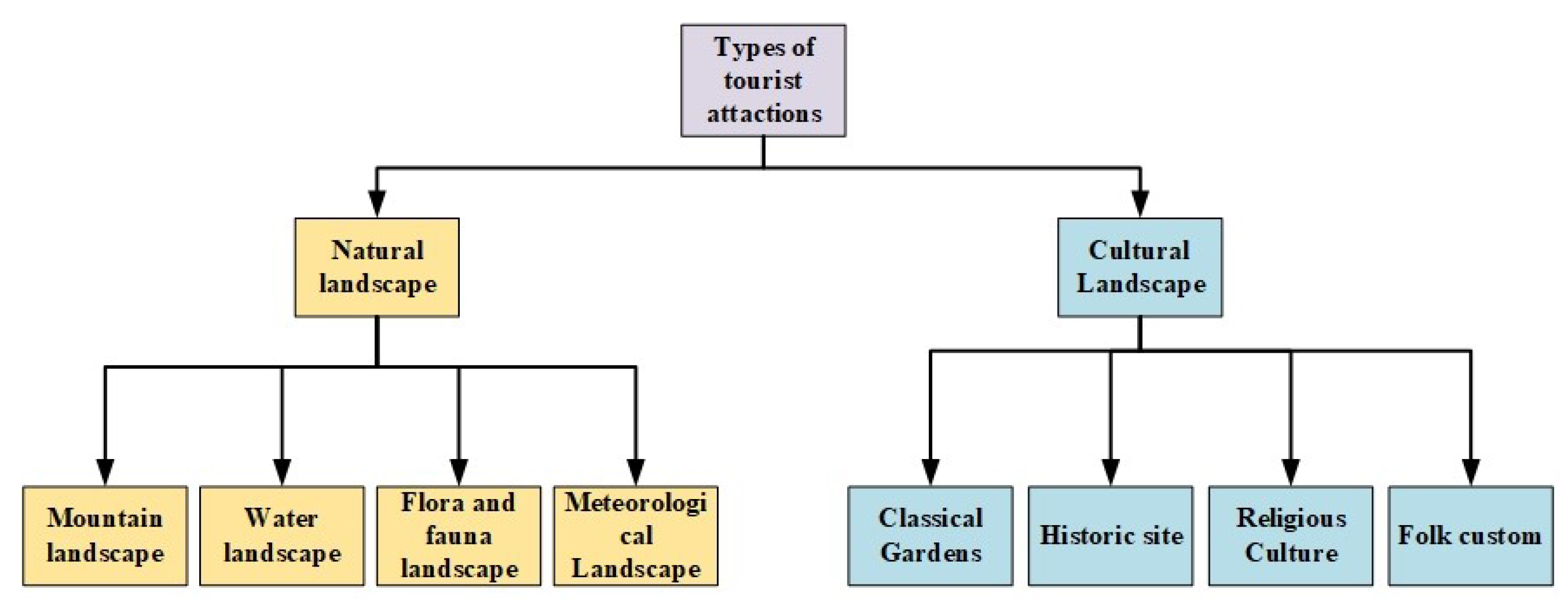
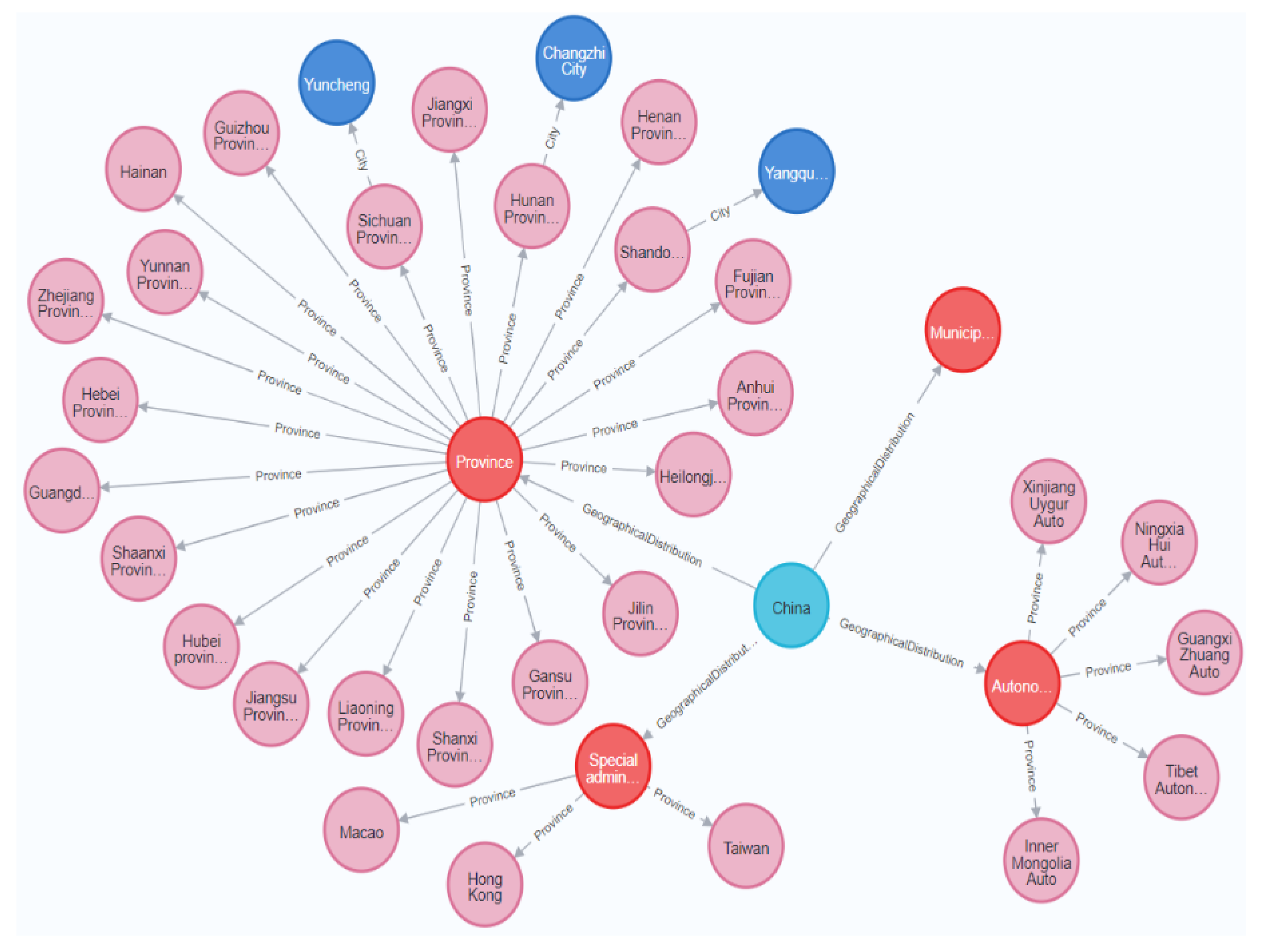
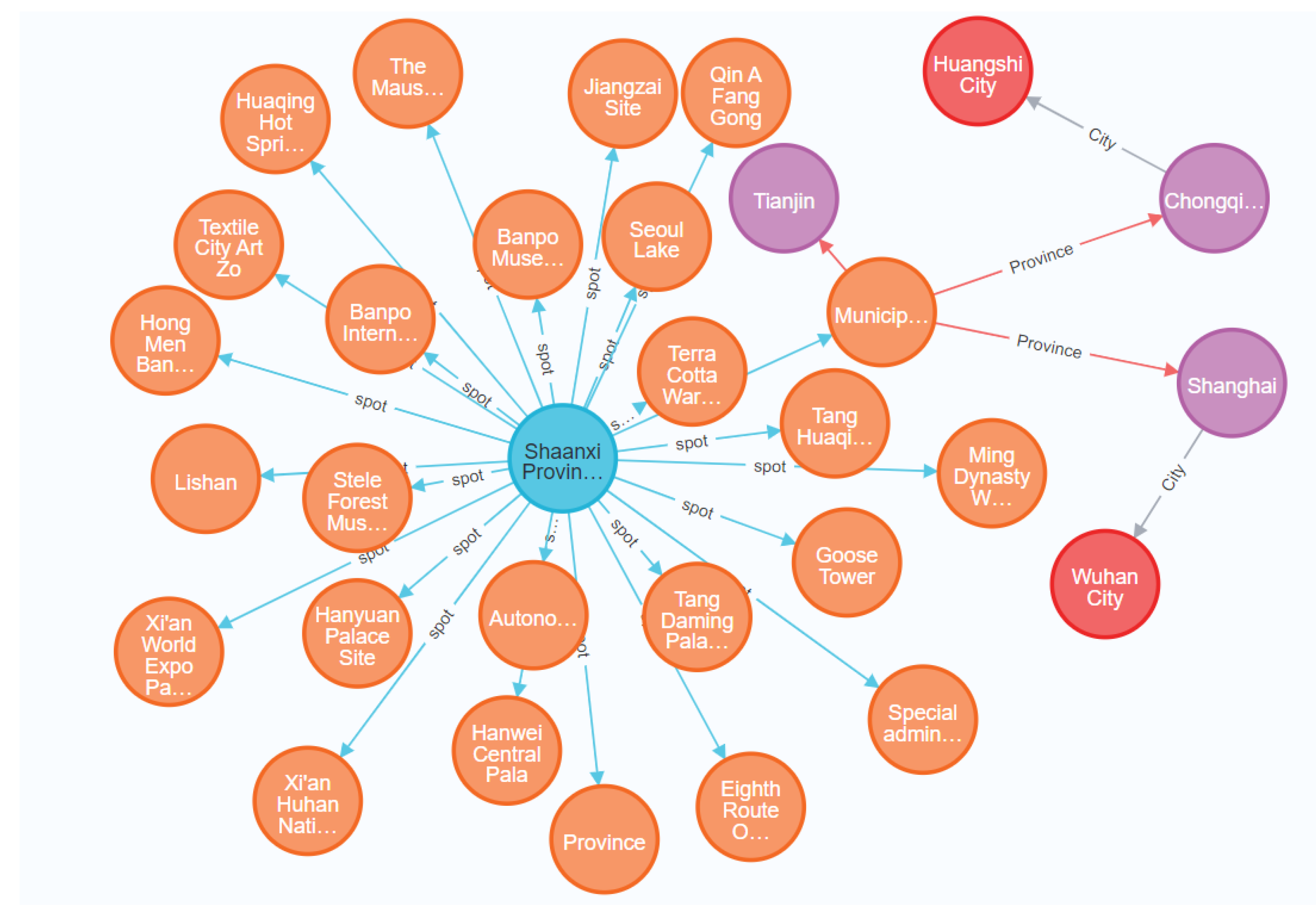
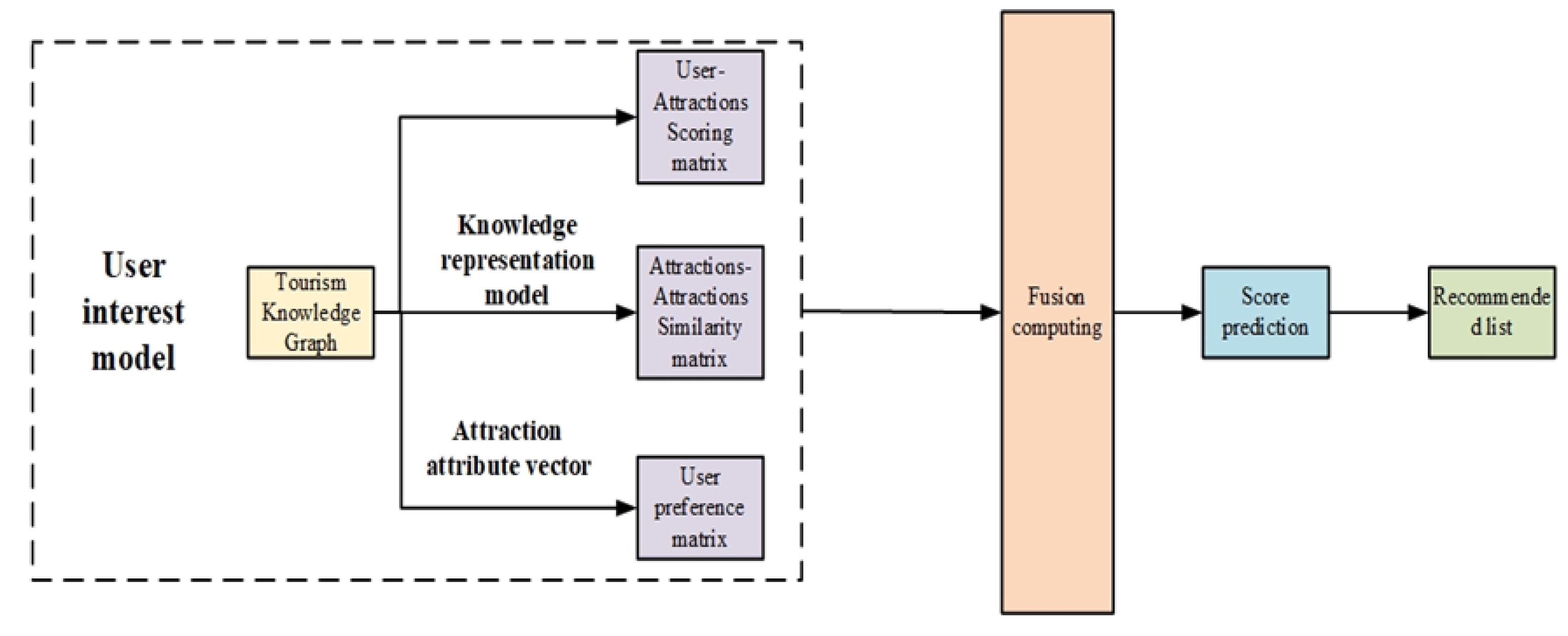


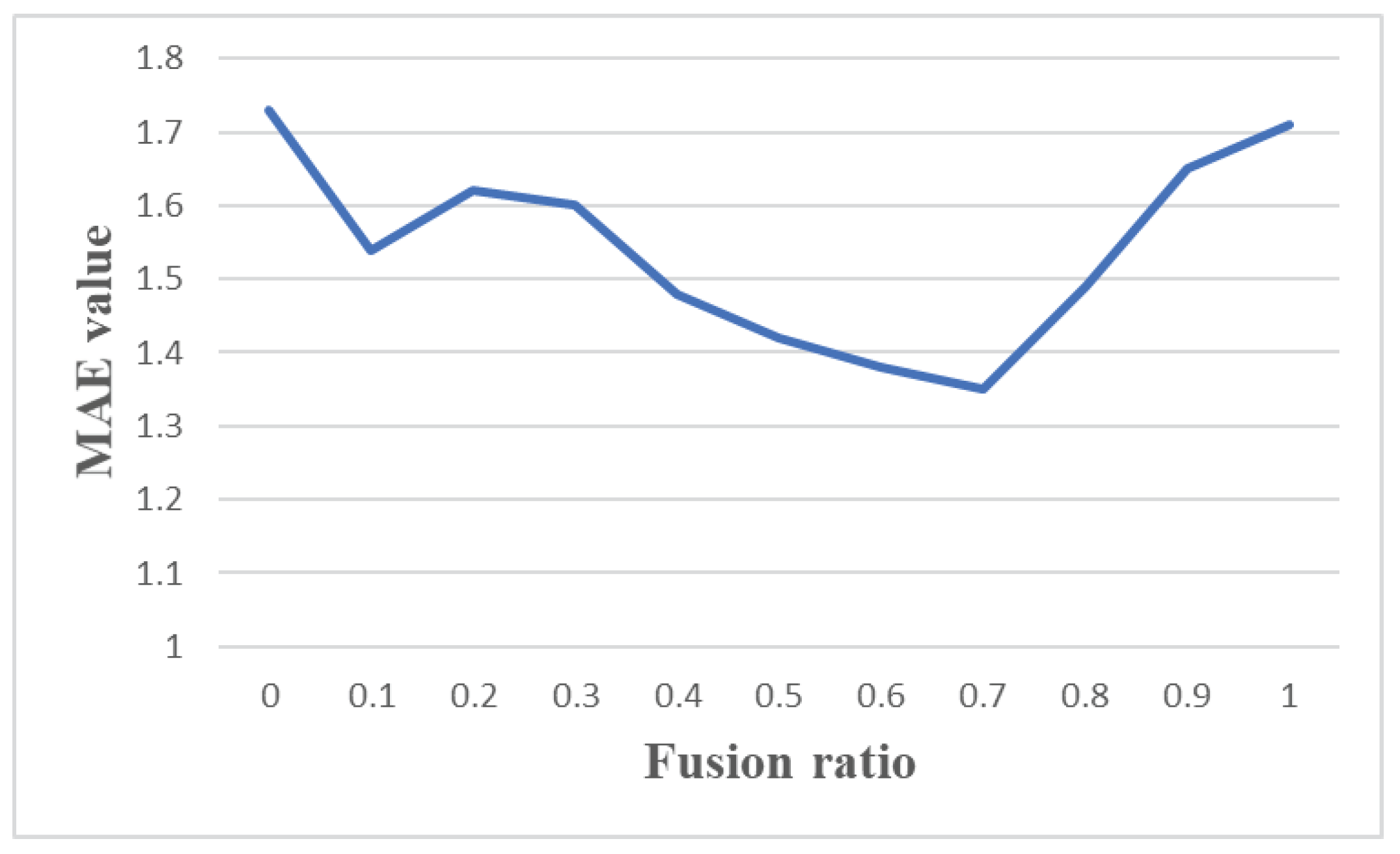
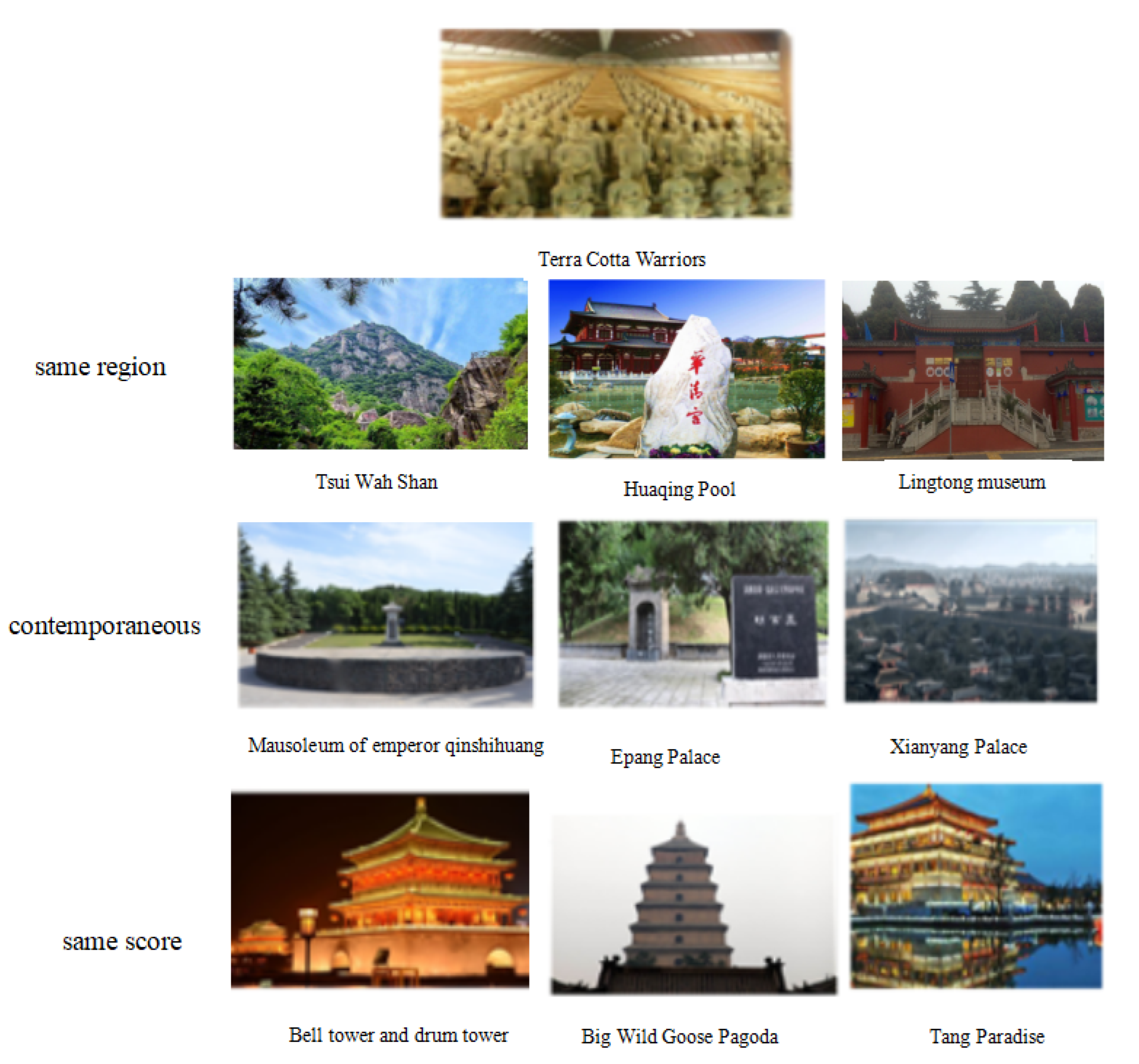
| Attraction Name | Geographical Location | Type | Dynasty | Ticket | Official Website | Rating | Opening Time |
|---|---|---|---|---|---|---|---|
| Terra Cotta Warriors | Lintong District, Xi’an City, Shaanxi Province | Historical site | Qin | 150 yuan | http://bmy.com.cn/ | 4.6 | 8:30–17:30 |
| Huaqing Pool | Lintong District, Xi’an City, Shaanxi Province | Mountain site | Republic of China | 110 yuan | http://www.hqc.cn | 4.7 | 9:00–17:00 |
| Bell Tower and Drum Tower | Beilin District, Xi’an City, Shaanxi Province | Historical site | Ming | 50 yuan | hhtp://www.xazgl.com | 4.5 | 8:30–20:30 |
| Giant Wild Goose Pagoda | Yanta District, Xi’an City, Shaanxi Province | Historical site | Tang | 50 yuan | http://www.xadayanta.com | 4.5 | 9:00–17:00 |
| Tsui Wah Shan | Chang’an District, Xi’an City, Shaanxi Province | Mountain landscape | Modern Times | 45 yuan | http://www.cuihuashan.com | 4.3 | 8:00–19:00 |
| Entity Class | Name | Attribute Class | Range | Description |
|---|---|---|---|---|
| Tourist attractions | Ticket price | Data | String | Price of admission to tourist attractions |
| Official site | Data | String | Official sites of tourist attractions | |
| Opening time | Data | String | Opening hours of tourist attractions | |
| Subordinate to the dynasty | Data | String | Establishment Time of tourist attractions | |
| Opening time Location | Object | Location of attractions | The location of the attraction | |
| Types | Object | Types of tourist attractions | Natural landscape or cultural landscape | |
| Average score | Object | Attractions rating | Visitors rate the site | |
| Types | Type name | Data | String | Natural landscape or cultural landscape |
| Score | Average score | Data | String | Visitors rate the site |
| Location | Regional ascription | Data | String | The location of the attraction |
| Entity | Attribute | ||||
|---|---|---|---|---|---|
| Attraction | Natural landscape | Cultural landscape | Location of attractions | Scoring | In the news |
| 9100 | 6200 | 2900 | 1100 | 9100 | 27,300 |
| Metrics Entity | Precision | Recall | F1-Score | ||||||
|---|---|---|---|---|---|---|---|---|---|
| HMM | Bi-LSTM | Bi-LSTM+CRF | HMM | Bi-LSTM | Bi-LSTM+CRF | HMM | Bi-LSTM | Bi-LSTM+CRF | |
| I-ORG | 0.0477 | 0.8997 | 0.9013 | 0.0464 | 0.7332 | 0.8168 | 0.0470 | 0.8080 | 0.8570 |
| B-PER | 0.0076 | 0.9247 | 0.9339 | 0.0075 | 0.8230 | 0.8723 | 0.0076 | 0.8708 | 0.9021 |
| O | 0.8678 | 0.9809 | 0.9861 | 0.8708 | 0.9921 | 0.9935 | 0.8693 | 0.9865 | 0.9898 |
| I-LOC | 0.0242 | 0.8025 | 0.8588 | 0.0251 | 0.8302 | 0.8595 | 0.0246 | 0.8161 | 0.8592 |
| B-ORG | 0.0092 | 0.8568 | 0.8500 | 0.0073 | 0.6627 | 0.7574 | 0.0081 | 0.7474 | 0.8011 |
| B-LOC | 0.0190 | 0.8069 | 0.8827 | 0.0172 | 0.8704 | 0.8767 | 0.0181 | 0.8375 | 0.8797 |
| I-PER | 0.0174 | 0.9309 | 0.9429 | 0.0183 | 0.8420 | 0.8809 | 0.0179 | 0.8842 | 0.9108 |
| Avg | 0.7720 | 0.9682 | 0.9756 | 0.7746 | 0.9689 | 0.9762 | 0.7753 | 0.9680 | 0.9758 |
| Mean Rank | Hits@10 | |
|---|---|---|
| TransD | 65 | 85.7 |
| B-TransD | 58 | 87 |
| Average Running Time (s) | ||||
|---|---|---|---|---|
| TransE-CF | 0.58 | 0.68 | 0.55 | 181.9 |
| TransE-C | 0.62 | 0.72 | 0.65 | 176.2 |
| KG-CF | 0.65 | 0.86 | 0.77 | 160.8 |
Publisher’s Note: MDPI stays neutral with regard to jurisdictional claims in published maps and institutional affiliations. |
© 2022 by the authors. Licensee MDPI, Basel, Switzerland. This article is an open access article distributed under the terms and conditions of the Creative Commons Attribution (CC BY) license (https://creativecommons.org/licenses/by/4.0/).
Share and Cite
Su, X.; He, J.; Ren, J.; Peng, J. Personalized Chinese Tourism Recommendation Algorithm Based on Knowledge Graph. Appl. Sci. 2022, 12, 10226. https://doi.org/10.3390/app122010226
Su X, He J, Ren J, Peng J. Personalized Chinese Tourism Recommendation Algorithm Based on Knowledge Graph. Applied Sciences. 2022; 12(20):10226. https://doi.org/10.3390/app122010226
Chicago/Turabian StyleSu, Xueping, Jiao He, Jie Ren, and Jinye Peng. 2022. "Personalized Chinese Tourism Recommendation Algorithm Based on Knowledge Graph" Applied Sciences 12, no. 20: 10226. https://doi.org/10.3390/app122010226
APA StyleSu, X., He, J., Ren, J., & Peng, J. (2022). Personalized Chinese Tourism Recommendation Algorithm Based on Knowledge Graph. Applied Sciences, 12(20), 10226. https://doi.org/10.3390/app122010226





